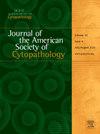Telecytology versus conventional rapid on-site evaluation for endobronchial ultrasound-guided fine needle aspiration: a single institution’s experience
Q2 Medicine
Journal of the American Society of Cytopathology
Pub Date : 2024-11-01
DOI:10.1016/j.jasc.2024.08.128
引用次数: 0
Abstract
Introduction
Telecytology (TC) has the advantage of allowing cytopathologists to remotely support multiple sites rapid on-site evaluation (ROSE) concurrently and represents a potential solution for an increased clinical demand for ROSE. In this study, we share our comparative experience of using TC versus conventional (in-person) ROSE for endobronchial ultrasound-guided fine needle aspiration (EBUS-FNA).
Materials and methods
We evaluated 475 consecutive cases of EBUS-FNA that underwent TC-ROSE from May 2020 to August 2021 along with 475 consecutive cases which had conventional ROSE from November 2019 to August 2021 at the University of Michigan. Concordant rates of preliminary and final diagnoses were calculated and compared between TC and conventional methods.
Results
While there was no significant difference in preliminary diagnostic rates of nondiagnostic, benign, atypical, and malignant categories between the TC and conventional cohorts, a significantly lower proportion of TC cases received a preliminary suspicious for malignancy diagnosis (2%) compared to the conventional group (4%) (P = 0.03). The concordance rate of preliminary and final diagnoses in TC and conventional ROSE was 96% and 94%, respectively. The average total number of passes per procedure did not differ significantly between TC and conventional ROSE (4.9 versus 4.7). While a relatively higher number of TC-ROSE cases collected dedicated passes compared with conventional ROSE (49% versus 40%), the difference was not statistically significant.
Conclusions
The performance of TC-ROSE for EBUS-FNA is comparable to that of conventional ROSE with similar performance metrics and therefore can be used as a feasible substitute.
支气管内超声引导下细针穿刺的远程细胞学与传统现场快速评估:一家医疗机构的经验。
导言:远程细胞学(TC)的优势在于允许细胞病理学家同时远程支持多个地点的快速现场评估(ROSE),是满足临床对 ROSE 日益增长的需求的潜在解决方案。在本研究中,我们分享了在支气管内超声引导下细针穿刺(EBUS-FNA)中使用 TC 与传统(现场)ROSE 的比较经验:我们评估了密歇根大学在 2020 年 5 月至 2021 年 8 月期间接受 TC-ROSE 的 475 例连续 EBUS-FNA 病例,以及在 2019 年 11 月至 2021 年 8 月期间接受传统 ROSE 的 475 例连续病例。计算并比较了TC和传统方法的初步诊断和最终诊断的一致率:虽然TC和传统方法的非诊断性、良性、非典型和恶性类别的初步诊断率无明显差异,但与传统方法组(4%)相比,TC病例中获得初步恶性可疑诊断的比例(2%)明显较低(P = 0.03)。TC 和传统 ROSE 初步诊断和最终诊断的一致率分别为 96% 和 94%。TC 和传统 ROSE 每次手术的平均总通过次数差异不大(4.9 对 4.7)。与传统 ROSE 相比,TC-ROSE 病例中收集专用通道的数量相对较多(49% 对 40%),但差异在统计学上并不显著:结论:TC-ROSE 用于 EBUS-FNA 的性能与传统 ROSE 相当,性能指标相似,因此可作为可行的替代方法。
本文章由计算机程序翻译,如有差异,请以英文原文为准。
求助全文
约1分钟内获得全文
求助全文
来源期刊

Journal of the American Society of Cytopathology
Medicine-Pathology and Forensic Medicine
CiteScore
4.30
自引率
0.00%
发文量
226
审稿时长
40 days
 求助内容:
求助内容: 应助结果提醒方式:
应助结果提醒方式:


